An escalator in my garden.
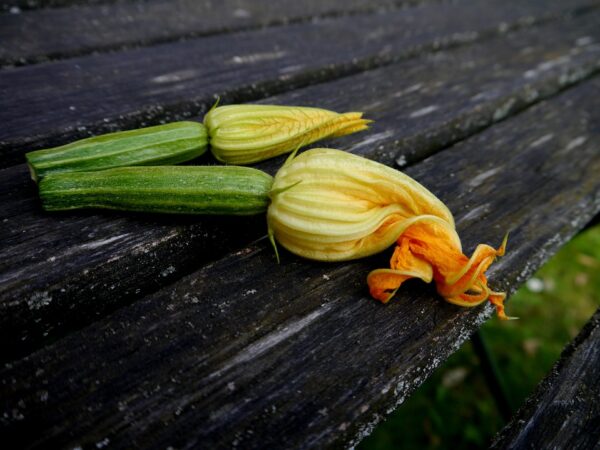
I have many memories of time spent as a child weeding our vegetable garden. I’m not necessarily saying they were good ones. My mom and dad were great gardeners but at that stage my siblings and I would have rather played Pac Man. One year my parents decided to put us in charge of the weeding. We ended up mowing the weeds that carpeted the rows between the vegetables! Amazingly enough we had a great harvest that year.
While I wasn’t a fan of weeding, I was a fan of vegetables, especially zucchini. My mom would make zucchini bread, zucchini soup, zucchini cookies and of course my favorite, stuffed zucchini. My home has plenty of room to garden but my sunniest spots have already been planted with flowers. I have had some veggies – like tomatoes and peppers – in pots but I would love to try zucchini. If only I had room.
Enter Incredible Escalator, a climbing zucchini from Renee’s Garden. I am so excited as this space-saving climbing zucchini will look beautiful scrambling over the arbor in my cutting garden. It will have to share some space with the Major Wheeler honeysuckle but I’m sure it will be fine. This climbing zucchini is the answer for those who might be spatially challenged and I can easily imagine it being used for some of my roof garden clients. The packet of seeds is ready to go but I will need to wait to plant until things really warm up and night temperatures are over 55 degrees. Giving the plants some compost and full sun will allow me to harvest in about 58 days. And enjoy zucchini bread in 59 days! Now I am more anxious than ever for spring.
2023 Perennial Plant(s) of the Year.
Drumroll please……the Perennial Plant Association’s Perennial of the Year is… Rudbekia ‘American Gold Rush’. Now to be honest, I am not a huge fan of black-eyed Susans because, in my experience, they seem to self sow EVERYWHERE. If I use them in a design they act like they to want to take over the design. ’American Gold Rush’ might have me re-thinking my former prejudice. This black-eyed Susan, which was also an AAS 2020 winner, is a shorter, more compact, dome-shaped plant. ‘American Gold Rush’ gets about 22” high by 40” wide and is hardy in Zones 4-9. It prefers full to part sun and will look beautiful in a perennial border or meadow planting. Its flowers, which are a bit lighter in color than the typical Rudbekia, are frequented by butterflies and pollinators and the seed heads are loved by birds. The seed heads also provide winter interest in the garden.
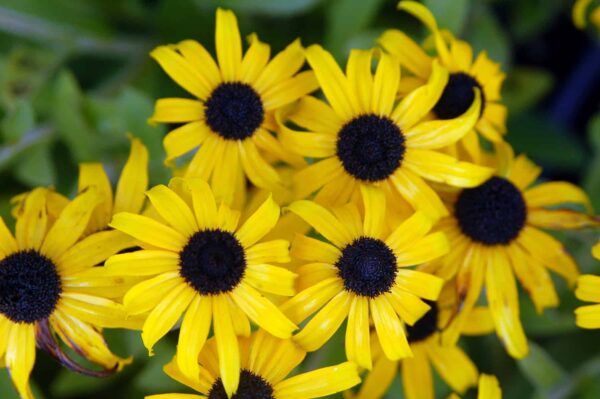
Best of all the thinner, hairier leaves of ‘American Gold Rush’ make the plant more resistant to Septoria leaf spot. Rudbekia’s susceptibility to this fungal disease is another reason I have not been a huge fan. This hybrid shows no sign of the fungus even in wetter conditions. I am happy to admit when I am wrong and it seems that ‘American Gold Rush’ might have me taking a second look at Rudbekias.
I am not wrong, however, when it comes to a penchant for great foliage. Many of you may have heard me speak about it during my talk “Look Ma, No Flowers” (for other presentation topics click here). When it comes to great foliage for your garden or container you cannot beat heuchera. I am especially enamored with heuchera ‘Wildberry’, which happens to be the Proven Winners National Perennial of the Year.
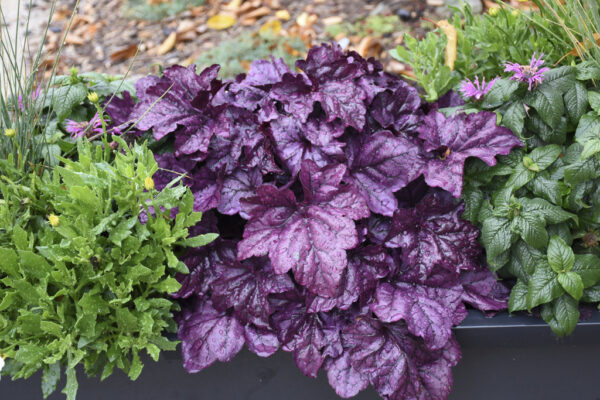
‘Wildberry’, which is part of the Dolce series, features large, scalloped, dark purple leaves with charcoal veining. It has white flowers that are covered with rosy pink calyxes but honestly with the gorgeous purple color the flowers are secondary – although the hummingbirds find them irresistable! ‘Wildberry’ gets about 14” high and 20” wide and performs equally well in sun or shade although I have found that, like many coleus, heuchera color better with some sun. Others in the Dolce series I have tried and loved include ‘Spearmint’ and ‘Cherry Truffles’. ‘Wildberry’ is a beauty I have used successfully in my gardens and containers.
Bark.
It is so tempting, when designing a garden, to start with the pretty stuff. You know, the flowers that captivate us with their colors and fragrance. While there is nothing wrong with beautiful flowers, a good design must start with the bones. Especially in New England where winters can seem long. Trees are a beautiful asset to the winter landscape and, like bones, can hold things together.
Those with beautiful bark are especially welcome in my garden designs. Consider the Japanese maple (Acer griseum). I have one in my garden and sited it just so its exfoliating cinnamon-colored bark could be backlit by the setting sun. Another beauty, Japanese stewartia (Stewartia pseudocamillia), has multi-colored bark, as well as camellia-like summer blooms and reliable red fall color. Coral bark maple (Acer palmatum) is another winner for the winter landscape with bright red stems that glow after it drops its golden-yellow and crimson leaves in autumn. The high-gloss, coppery-brown bark of Tibetan cherry (Prunus serrula) makes quite a statement in the winter landscape.
Other trees with interesting bark include Snakebark maple (Acer davidii), Japanese red pine (Pinus densiflora), and American sycamore (Platanus occidentalis) – although you will need lots of room as this one gets BIG. I think the most amazing bark I have ever seen is the Rainbow eucalyptus (Eucalyptus deglupta); it took my breath away at the Miami Beach Botanical Garden. Unfortunately it is not hardy in our zone so you will have to plan a trip to Florida to see it yourself!
My battle with social media.
My niece Anna and I play a game where we ask, “Would you rather?” type questions. My dilemma with social media, i.e.: Facebook, Instagram, Twitter, etc., reminds me of that game and comes down to this: Would you rather be famous? Or do what you love?
I have learned, as a business owner, that social media can become a beast. One that needs to be fed…constantly. The problem with that is I am a very small business with only 3 employees (me, myself, and I). Any time spent on social media is time spent away from bookkeeping, marketing, office work, not to mention actual gardening. Do I want to pursue “likes” in the hope, one day, of getting products to sponsor me? Do I really want to be an influencer? The short answer is no. That might be fine for some, but I have found the deeper I get into social media the more all-consuming it becomes. I had one fellow gardener confess “I am addicted to this.” And she’s good at it with lots of engaged followers but how? She is a small business owner like me and has limited time so how can she keep her business going AND the beast fed? She has hired a company to run her social media platforms. That company will engage with followers, like and comment. This bothers me.
In an age where things are so often not what they seem I yearn for authentic. I want to be real. (For a look at an authentic post click here) Do we present ourselves as real while someone else is behind the curtain pulling the strings? Is that honest? If someone takes time to comment on one of my posts, shouldn’t I be the one replying? And honestly, I would rather have my hands in the dirt then glued to my phone.
I will probably never be an influencer. That’s okay – I’ll be a gardener.

Got grass?
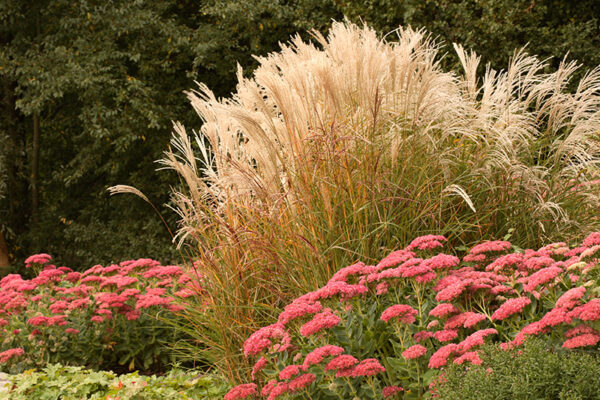
No, I am not talking about cannabis, although with dispensaries on every corner it seems like it would be easy enough to get. I am referring to ornamental grasses. To me they are the stars of the fall garden. They are very low maintenance and bring excitement and movement to the garden during a time when many plants are fading out. With different growth habits, sizes and colors, there is an ornamental grass for any garden. Maiden grass (Miscanthus) features plumes that are typically silvery, or pink-tinged. Some Miscanthus can grow to be over 6 feet tall. These are especially good in a privacy border. Of course, there are also dwarf varieties, like ‘Little Kitten’, and ‘Adagio’. Switchgrass (Panicum) tends to be more upright and features dangling seed heads which are beautiful when backlit by the autumn sun. Feather reed grass (Calamagrostis) ‘Karl Foerster’ is a tried-and-true performer with a narrow upright habit; it is also one of the first grasses to green up in the spring. This is important as many grasses are considered “warm season” and need the heat of summer before they really perform. Little Bluestem (Schyzachyrium) is a wonderful columnar native grass; I especially like ‘Standing Ovation’ – it’s blue-green blades turn a lovely wine red in fall.
Most ornamental grasses require full sun but there are a few that can tolerate some shade. If your garden is sun-challenged try planting northern sea oats (Chasmanthium latifolium), Japanese forest grass (Hakonechloa) or sedges (Carex).
If you want a grass that makes you feel better this fall skip the dispensary and head to your local nursery.

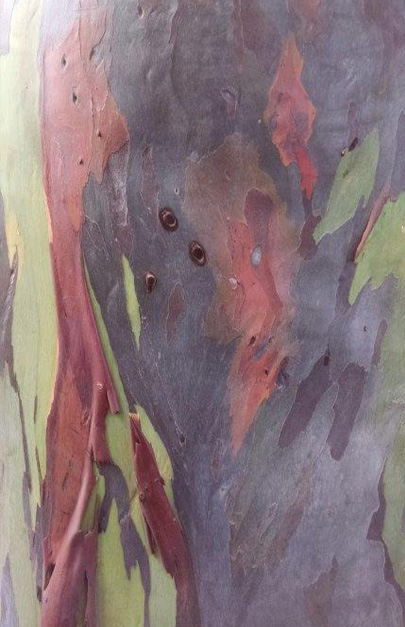
Follow Us!